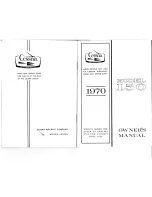
12
> flying in turbulence
Only an experienced and proficient pilot should ever fly in any kind of turbulent condi-
tions. The pilot has to fly ‘actively’ (to maintain correct air speed and glider attitude) in
effect ‘absorbing’ turbulence with the controls and weight shift to keep the glider over-
head and help prevent any deflations and always to be extremely careful not to stall the
wing, through bad pilot input or use of motor, especially through overuse of thrust and/or
the controls.
Always remember that by applying thrust this pushes the pilot forwards relative to the
wing, increasing the angle of attack and wing loading, at least momentarily. This in effect
shortens the available brake travel (speed range) of the glider, making it stall at a higher
brake position. For this reason, under power it is not recommended to use more than 70%
of the brake travel and to generally use less brake than you would when not under thrust,
especially as you increase power. If the pilot encounters an area of turbulence just as
they apply power (they are pushed forward by the power of the engine and the angle of
attack of the wing therefore increases), one should be extremely careful as the control
and flight behaviour of the wing is very different whilst under power.
In turbulent conditions, it is possible for your wing to suffer from either an “asymmetric”
or “symmetric” collapse. Also known as “tucks”, these are described in the following
paragraphs, along with a description of what to expect and the recovery techniques
recommended.
-- asymmetrical tuck/collapse
An asymmetric collapse, is a longitudinal (lengthwise) collapse of a part of the wing (say
20 – 70%) which is normally caused by turbulence (although it is also possible to indu-
ce collapses through poor pilot input). In un-powered flight, any tucks or collapses on
the Kinetik should sort themselves out automatically within 90 degrees. If you have a
collapse whilst under power, you should always ease off the thrust gradually, as the
thrust of the motor can considerably complicate the wing’s reactions and recovery beha-
viour. In any case, the pilot should know how to first prevent and, failing this, to deal
with, an asymmetric collapse. They should also be familiar with the required recovery
procedures and techniques to return the glider to normal flight, with the minimum loss
of height or directional control.
If you have an asymmetric collapse, remember: “Course, then Correction”. First try to
maintain a SAFE course, WITHOUT STALLING THE WING BY OVER-CORRECTING, by first
weight shift towards the (still inflated) flying side of the wing (this will give a better wing
loading and augment the internal pressure of the wing) and apply around 20-40% brake
on the open side of the wing to try to minimise the turn induced by the collapse.
Remember that you should have gradually reduced the power of the engine.
BE CAREFUL when trying to stop the turn of the glider after a collapse not to use too
much brake and so stall the flying part of the wing, as this could cause more problems
Summary of Contents for Kinetik 25
Page 1: ...K I N E T I K m a n u a l...
Page 2: ......
Page 3: ...3 Windtech w w w w i n d t e c h e s K I N E T I K 2 5 2 7 3 0 flight manual...
Page 18: ...18...
Page 20: ...20...
Page 24: ...24 flight log size date site duration flight details K K I I N N E E T T I I K K...
Page 25: ......










































